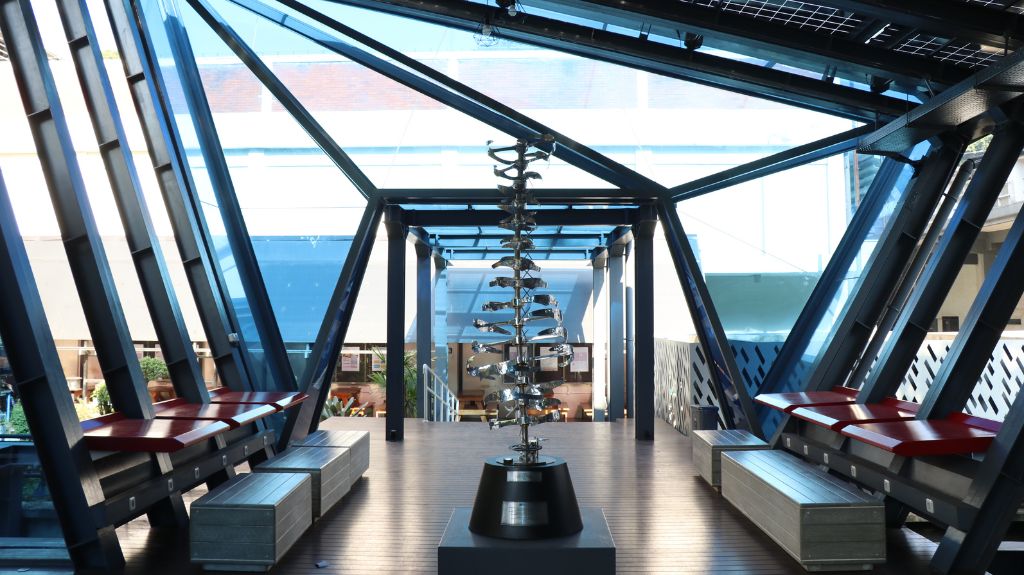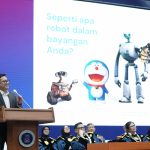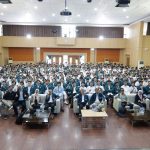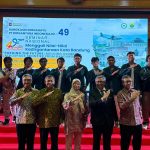1. Introduction
Graduate program of FTMD consists two programs, i.e. master program and doctoral program. These programs have three major which are mechanical engineering, aerospace engineering, and material engineering.
2. Master Program
Every major in master programs has sub-degree major which are
- Mechanical Engineering:
- Design, Dynamics, and Control
- Sustainable Energy Engineering
- Production Engineering and Automation
- Aerospace Engineering:
- Flight Mechanics
- Aerodynamics and Propulsion
- Aircraft Design, Operation, and Maintenance
- Lightweight Structure
- Material Science and Engineering:
- Material Science and Engineering
3. Career Prospect and Motivation for Master Program
4. Curriculum of Master Program
- Program Educational Objective (PEO)
Referring to the 2019 curriculum document, master program is committed to produce graduates who can contribute positively to academic or professional society, both at national and international level, with general qualities that are reflected in the program educational objectives (PEO).
- PEO 1 – Having moral integrity, discipline, and mutual respect, fairness, and responsibility;
- PEO 2 – Having the ability to consolidate/build knowledge and skills in the field of major study (mechanical engineering/aerospace engineering/material science and engineering) and interdisciplinary science;
- PEO 3 – Having the ability to create and innovate, working effectively both individually and in groups, communicating well orally and in writing, learning throughout life, and adapting to the research environment.
Mechanical Engineering
The PEOs are also relevant with the Indonesian National Qualification Framework (KKNI), as shown in the following table.
| PEO | Indonesian National Qualification Framework (KKNI) | |||
| Capable to apply science, technology, and/or art in their expertise and adaptable to various situations faced during solving a problem. | Mastering in-depth general and specific theoretical concepts of a certain knowledge and capable to formulate related problem solving procedure | Capable to make strategic decisions build upon data and information analysis and be able to give a clue in choosing several alternative solutions | Responsible for own work and can be held accountable for the achievement of the organization’s work | |
| Objective 1 | V | |||
| Objective 2 | V | V | V | |
| Objective 3 | V | V | V | V |
Aerospace Engineering
The PEOs are also relevant with the Indonesian National Qualification Framework (KKNI), as shown in the following table.
| PEO | Indonesian National Qualification Framework (KKNI) | ||
| Capable of developing knowledge, technology, and/or art in their scientific field or professional practice through research to produce innovative and tested work | Capable of solving science, technology, and/or art problems in their scientific fields through an interdisciplinary or multidisciplinary approach | Capable of managing research and development beneficial to society and science and getting national and international recognition | |
| Objective 1 | V | ||
| Objective 2 | V | V | V |
| Objective 3 | V | V | V |
Material Science and Engineering
The PEOs are also relevant with the Indonesian National Qualification Framework (KKNI), as shown in the following table.
| PEO | Indonesian National Qualification Framework (KKNI) | |||
| Applying science, technology, and/or art in their expertise and being adaptable to various situations when solving a problem | Mastering in-depth general and specific theoretical concepts of certain knowledge and formulating related problem-solving procedures | Making strategic decisions based on data and information analysis and giving a clue in choosing several alternative solutions | Being responsible for their own work and accountable for achieving the organization’s work | |
| Objective 1 | V | |||
| Objective 2 | V | V | V | V |
| Objective 3 | V | V | V | V |
Mechanical Engineering
The PEOs are also relevant with the Indonesian National Qualification Framework (KKNI), as shown in the following table.
| PEO | Indonesian National Qualification Framework (KKNI) | |||
| Capable to apply science, technology, and/or art in their expertise and adaptable to various situations faced during solving a problem. | Mastering in-depth general and specific theoretical concepts of a certain knowledge and capable to formulate related problem solving procedure | Capable to make strategic decisions build upon data and information analysis and be able to give a clue in choosing several alternative solutions | Responsible for own work and can be held accountable for the achievement of the organization’s work | |
| Objective 1 | V | |||
| Objective 2 | V | V | V | |
| Objective 3 | V | V | V | V |
Aerospace Engineering
The PEOs are also relevant with the Indonesian National Qualification Framework (KKNI), as shown in the following table.
| PEO | Indonesian National Qualification Framework (KKNI) | ||
| Capable of developing knowledge, technology, and/or art in their scientific field or professional practice through research to produce innovative and tested work | Capable of solving science, technology, and/or art problems in their scientific fields through an interdisciplinary or multidisciplinary approach | Capable of managing research and development beneficial to society and science and getting national and international recognition | |
| Objective 1 | V | ||
| Objective 2 | V | V | V |
| Objective 3 | V | V | V |
Material Science and Engineering
The PEOs are also relevant with the Indonesian National Qualification Framework (KKNI), as shown in the following table.
| PEO | Indonesian National Qualification Framework (KKNI) | |||
| Applying science, technology, and/or art in their expertise and being adaptable to various situations when solving a problem | Mastering in-depth general and specific theoretical concepts of certain knowledge and formulating related problem-solving procedures | Making strategic decisions based on data and information analysis and giving a clue in choosing several alternative solutions | Being responsible for their own work and accountable for achieving the organization’s work | |
| Objective 1 | V | |||
| Objective 2 | V | V | V | V |
| Objective 3 | V | V | V | V |
- Curriculum Structure
Mechanical Engineering
In general, the curriculum structure of the Mechanical Engineering Masters Study Program is shown in Table below.
| Semester I | Semester II | ||||||
| No | Code | Course Name | Credits | No | Kode | Course Name | Credits |
| 1 | MS5100 | Compulsory: Reseach methodology | 3 | 1 | MS5200 | Wajib Prodi: Penulisan Karya Ilmiah dan Tesis MS | 3 |
| 2 | MS51xx | First compulsory course | 3 | 2 | MS52xx | Thired compulsory course | 3 |
| 3 | MS51xx | Second compulsory course | 3 | 3 | MS52xx | Fourth compulsory course | 3 |
| Total | 9 | Total | 9 | ||||
| Semester III | Semester IV | ||||||
| No | Kode | Mata Kuliah | SKS | No | Kode | Mata Kuliah | SKS |
| 1 | MS6090 | First Thesis | 3 | 1 | MS6091 | Second Thesis | 3 |
| 2 | MS60xx | First elective course
|
3 | 2 | MS60xx | Third elective course
|
3 |
| 3 | MS60xx | Second elective course
|
3 | 3 | MS60xx | Fourth elective course
|
3 |
| Total | 9 | Total | 9 | ||||
Below, the list of compulsory sub-degree course:
- Design, Dynamics, and Control
| Odd semester | Even semester | ||||||
| No | Code | Course | Credits | No | Code | Course | Credits |
| 1. | MS5110 | Finite element method for design | 3 | 1. | MS5210 | System Dynamics, measurement, signal processing | 3 |
| 2. | MS5111 | Applied engineering mathematics | 3 | 2. | MS5211 | Applied statistics | 3 |
- Sustainable Energy Engineering
| Odd semester | Even semester | ||||||
| No | Code | Course | Credits | No | Code | Course | Credits |
| 1. | MS5120 | Thermofluid engineering | 3 | 1. | MS5220 | Energy sustainability | 3 |
| 2. | MS5121 | Energy conversion Analysis Method | 3 | 2. | MS5121 | Modelling and optimization of thermal system | 3 |
- Production Engineering and Automation
| Odd Semester | Even Semester | ||||||
| No | Code | Course | Credits | No | Code | Course | Credits |
| 1. | MS5130 | Product design and Development | 3 | 1. | MS5230 | Geometric Dimensioning and tolerancing | 3 |
| 2. | MS5131 | Manufacturing processes and Product life cycles. | 3 | 2. | MS5231 | Modelling of Manufacturing System | 3 |
Beside the compulsory courses, there are also elective courses, here the lists:
| Odd semester | Even Semester | |||||||
| No | Code | Course | Credits | No | Code | Course | Credits | |
| 1. | MS5112 | Mechanical Vibration | 3 | 1. | MS5112 | Mechanical Vibration
|
3 | |
| 2. | MS6000 | Special Topics in Mechanical A | 2. | MS6000 | Special Topics in Mechanical A | |||
| 3. | MS6001 | Special Topics in Mechanical B | 2 | 3. | MS6001 | Special Topics in Mechanical B | 2 | |
| 4. | MS6010 | Control engineering | 3 | 4. | MS6010 | T Control engineering
|
3 | |
| 5. | MS6011 | Advance CAD/CAE | 3 | 5. | MS6011 | Advance CAD/CAE
|
3 | |
| 6. | MS6012 | Methodology and Design Optimization | 2 | 6. | MS6012 | Methodology and Design Optimization
|
2 | |
| 7. | MS6013 | Advance Mechanic in Designing Process | 2 | 7. | MS6013 | Advance Mechanic in Designing Process | 2 | |
| 8. | MS6020 | Advanced ThermoFluid Engineering | 3 | 8. | MS6020 | Advanced ThermoFluid Engineering | 3 | |
| 9. | MS6021 | Technology of Renewable Energy on Grid | 3 | 9. | MS6021 | Technology of Renewable Energy on Grid
|
3 | |
| 10. | MS6022 | Heat Exchanger | 2 | 10. | MS6022 | Heat Exchanger
|
2 | |
| 11. | MS6023 | Integration of Renewable Energy on Grid | 2 | 11. | MS6023 | Integration of Renewable Energy on Grid | 2 | |
| 12. | MS6030 | Reverse Engineering | 3 | 12. | MS6030 | Reverse Engineering | 3 | |
| 13. | MS6031 | Precision Machining | 3 | 13. | MS6031 | Precision Machining
|
3 | |
| 14. | MS6032 | Production system | 2 | 14. | MS6032 | Production system
|
2 | |
| 15. | MS6033 | Industrial Robotic | 2 | 15. | MS6033 | Industrial Robotic | 2 | |
Aerospace Engineering
Material Science and Engineering
5. Curriculum of Doctoral Program
6. Research Group Website for Doctoral Program
Research group of every Study Program has own website. This website consist of interest research topic, ongoing research, researcher including lecturers students, and laboratory technician, laboratory facility and partnership with any related industries. Prospective doctoral student can also finds contact of lecturer that can be a supervisor in doctoral program.
- Mechanical Engineering
- Design, Dynamics, and Control : https://ftmd.itb.ac.id
- Sustainable Energy Engineering : https://ftmd.itb.ac.id
- Production Engineering and Automation : https://ftmd.itb.ac.id
- Aerospace Engineering
- Flight Mechanics : https://ftmd.itb.ac.id
- Design Aircraft, Operation, and Maintenance : https://ftmd.itb.ac.id
- Lightweight Structure : https://ftmd.itb.ac.id
- Material Science and Engineering
Material Science and Engineering : https://itm.ftmd.itb.ac.id
7. Registration Procedures for Master and Doctoral Programs
8. Graduate School and Registration Website
Detail information about graduate student at ITB can be accessed at website www.sps.itb.ac.id. This website consists of graduate school program, the major and the accreditation, journal website, and many facilities like e-journal. Beside that, there is another website for prospective graduate student, i.e. https://admission.itb.ac.id/home/ . This website explain detail information about registration procedures, like document and how to upload that.
9. Scholarship Information
10. Download Area







